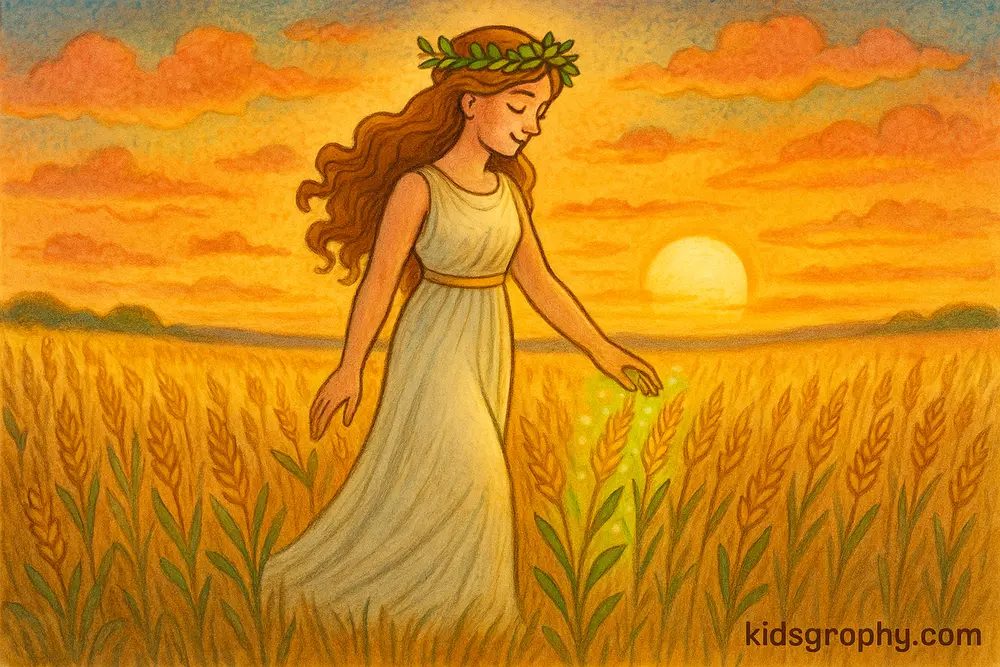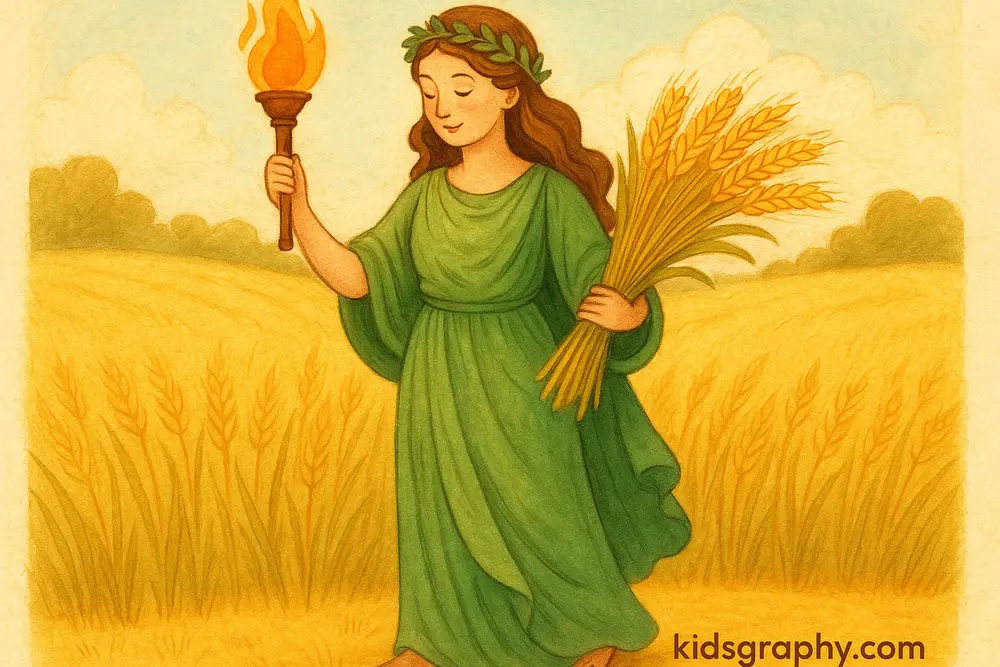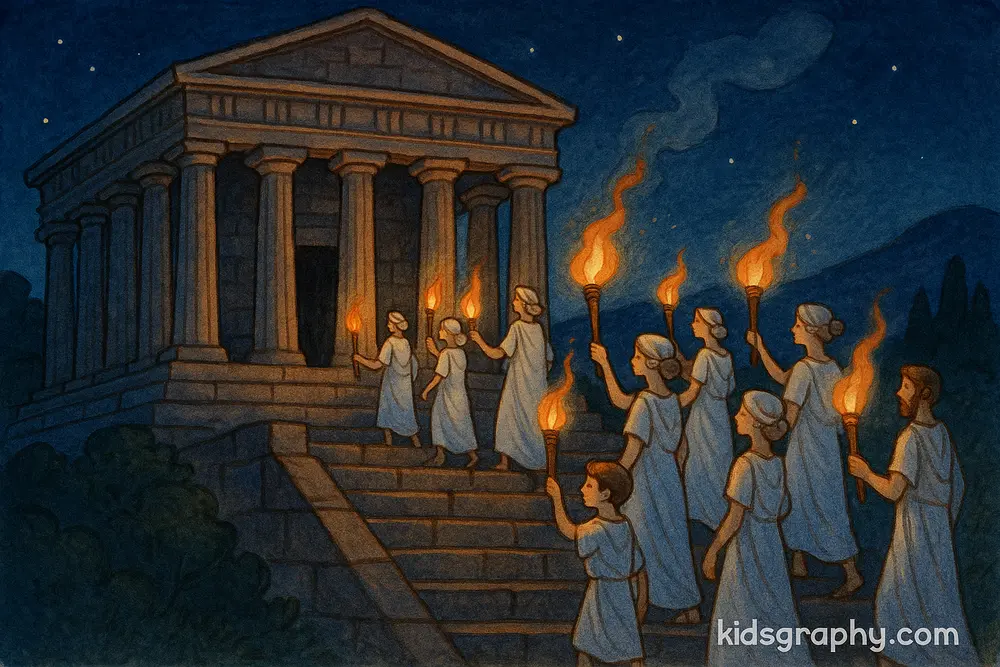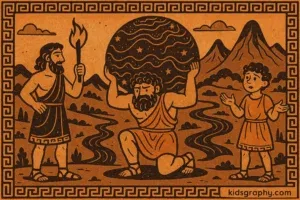In the rich world of Greek mythology, where gods ruled the skies, seas, and underworld, Demeter reigned over something more grounded—the earth’s harvest. She is one of the most important goddesses, deeply loved by ancient Greeks for her role in feeding people and shaping the seasons.
Her story is one of love, loss, and renewal, especially through her bond with her daughter Persephone.
Read more: Prometheus in Greek Mythology: The Fire Bringer
Who Is Demeter in Greek Mythology?
Demeter is the goddess of agriculture, grain, and fertility. She is one of the Twelve Olympians, the major gods of Mount Olympus.
Demeter is the deity responsible for the growth of crops, the changing seasons, and the cycle of life and death in nature.
She is the daughter of the Titans Cronus and Rhea, and the sister of Zeus, Hera, Poseidon, Hades, and Hestia.
Demeter and Persephone: A Mother’s Grief
The most famous myth about Demeter is the story of her daughter, Persephone.
Persephone was abducted by Hades, the god of the underworld, to be his queen. Demeter was heartbroken and searched the world for her. During this time, she refused to let crops grow, causing a great famine on Earth.
Eventually, Zeus made a deal: Persephone would spend part of the year with Hades and part with Demeter.
This myth explains the seasons:
- When Persephone is with Demeter, the Earth is warm and crops grow — spring and summer.
- When Persephone is in the underworld, Demeter grieves — fall and winter.
Demeter’s Powers and Iconic Weapon
Demeter was not a warrior like Athena or Ares, but she had her own form of power. She controlled growth, harvest, fertility, and nourishment. Her presence made the land bloom, and her absence brought barrenness.
Although Demeter didn’t carry a traditional weapon like a sword or spear, her most iconic “weapon” was her sickle—a curved tool used to harvest grain. In many myths and artworks, she is seen holding this tool, symbolizing her control over life and food.
Read more: Titans in Greek Mythology: Gods Before Olympus
Demeter’s Symbols and Sacred Animals
The Demeter’s symbols are all connected to growth, life, and the Earth. Some of the most famous include:
- Sheaf of wheat or barley – Represents the harvest
- Torch – Symbol of her search for Persephone
- Cornucopia – Horn of plenty, abundance
- Sickle – Harvest and natural cycles
- Poppy flower – Often found in wheat fields, symbol of sleep and cycles
Her sacred animals include:
- Serpents – Often shown pulling her chariot
- Pigs – Sacrificed during harvest festivals
- Geese – A symbol of fertility
Read more: Chaos in Greek Mythology: The First Being of Creation
Worship of Demeter in Ancient Greece
Demeter was deeply honored by the ancient Greeks. Her most important sanctuary was in Eleusis, near Athens. There, the famous Eleusinian Mysteries were held—secret religious ceremonies believed to offer hope for life after death.
People prayed to Demeter for:
- A good harvest
- Healthy children
- Fertile land
- Protection during famine
These rituals were so sacred that details were never written down. Even today, much of what happened remains a mystery.
Demeter in Later Culture
Demeter’s story influenced many later myths and works of art. She appears in:
- Roman mythology as Ceres (which is where we get the word “cereal”)
- Poetry and plays, especially those dealing with motherhood or the changing seasons
- Modern media, including books, films, and games featuring Greek gods
Read more: Cronus in Greek Mythology: Titan of Time and Power
What Demeter Represents Today
Demeter is more than a goddess of grain. She is a symbol of:
- Motherhood and unconditional love
- Nature’s cycles—birth, death, and rebirth
- The power of women and feminine strength
- The connection between human life and the earth
More Stories: Greek Mythology
FAQ: Demeter in Greek Mythology
Demeter is the goddess of agriculture, grain, and the harvest. She is one of the twelve Olympian gods.
Her most well-known myth is about her daughter Persephone, whose abduction by Hades caused the seasons to change.
Demeter’s symbols include wheat, a torch, a sickle, and the cornucopia, all related to farming and nature.
She is not known for fighting, but her sickle is seen as her iconic tool and symbol of harvest power.
She provided food and controlled the seasons. People prayed to her for good harvests and healthy crops.
Read More: Ajax in Greek Mythology: Warrior of Honor and Tragedy











